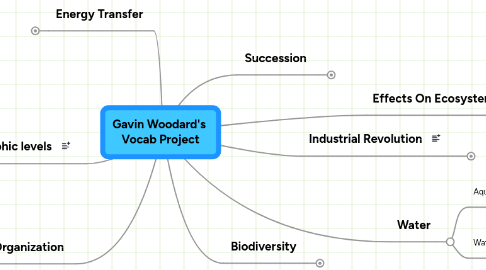
1. Levels Of Organization
1.1. Organism
1.1.1. Any Form of Life
1.1.1.1. Fish
1.1.1.2. Fox
1.1.1.3. Person
1.1.1.4. plants
1.2. Population
1.2.1. group of individials of the same species found in a given area at a given time
1.2.1.1. Population of people in a town
1.2.1.2. How many dogs are in a pet store
1.3. Community
1.3.1. Populations of living organisms that interact with one another in an ecosystem
1.3.1.1. Dinosaurs interact with other dinosaurs and plants in order to survive.
1.4. Ecosystem
1.4.1. Group of organisms that interact with another, non living physical environment oas one unit
1.5. Biome
1.5.1. Region of Earth that is inhabited by distict types of plants/animals
1.5.1.1. Antarctica provides a habitat for distinct animals such as the penguin. No one else on earth could sustain life for a penguin.
1.5.2. Types Of Biomes
1.5.2.1. Rain Forest
1.5.2.2. Temperate Deciduous Forest
1.5.2.3. Desert
1.5.2.4. Tundra
1.5.2.5. Freshwater Biome
1.5.2.6. Marine Biome
1.5.2.7. Coniferous forest
1.5.2.8. Grassland/ Savannah
1.6. Biosphere
1.6.1. Layer of soil, water, air that sustains life.
1.6.1.1. Earth sustain all living things. It has soil, water, and air to sustain us.
2. Energy Transfer
2.1. Food Chain
2.1.1. Food chains shows one way energy may be transfered between organisms
2.2. Food web
2.2.1. Food webs show different ways that energy can be transfered between organisms.
3. Trophic levels
3.1. Producer
3.1.1. Producers make their own energy. They gather 100% of energy. All other levels depend on producers to produce energy for the rest of the organisms.
3.2. Primary consumer
3.2.1. Primary consumers eat the producers. They gain 10% of the total energy.
3.3. secondary consumer
3.3.1. Secondary consumers eat the primary consumers gaining 1% of the total energy that the producer made.
3.4. Tertiary Consumer
3.4.1. Tertiary consumers eat the secondary consumers and gain .1% of the total energy produced from the producer.
4. Biodiversity
4.1. Abiotic factors
4.2. Biotic factors
4.3. Hot Spots
5. Succession
5.1. Primary Succesion
5.1.1. Primary Species
5.2. Secondary Succession
5.3. Ecological Succession
5.4. Climax Community
6. Effects On Ecosystems
6.1. Limiting factors
6.1.1. Predators
6.1.2. Living Space
6.1.3. Natural Disasters
6.1.4. The Black Plague
6.1.5. S- Curve
6.2. Carrying Capacity
6.3. Population Growth
6.4. Logistic growth
7. Industrial Revolution
7.1. Exponential Growth
7.1.1. J-Curve
7.2. Sustainability
8. Water
8.1. Aquifer
8.2. Water Pollution
8.2.1. Point Source
8.2.2. Non- Point Source
